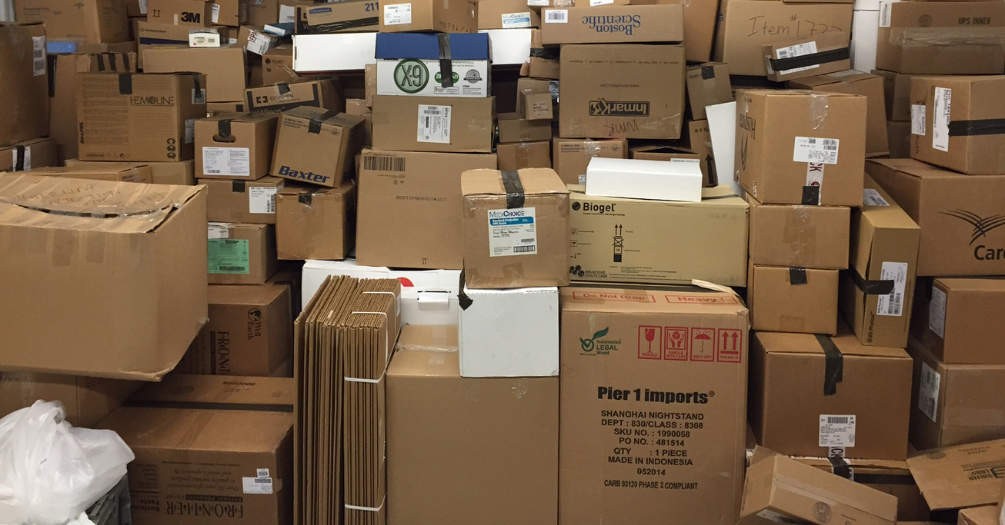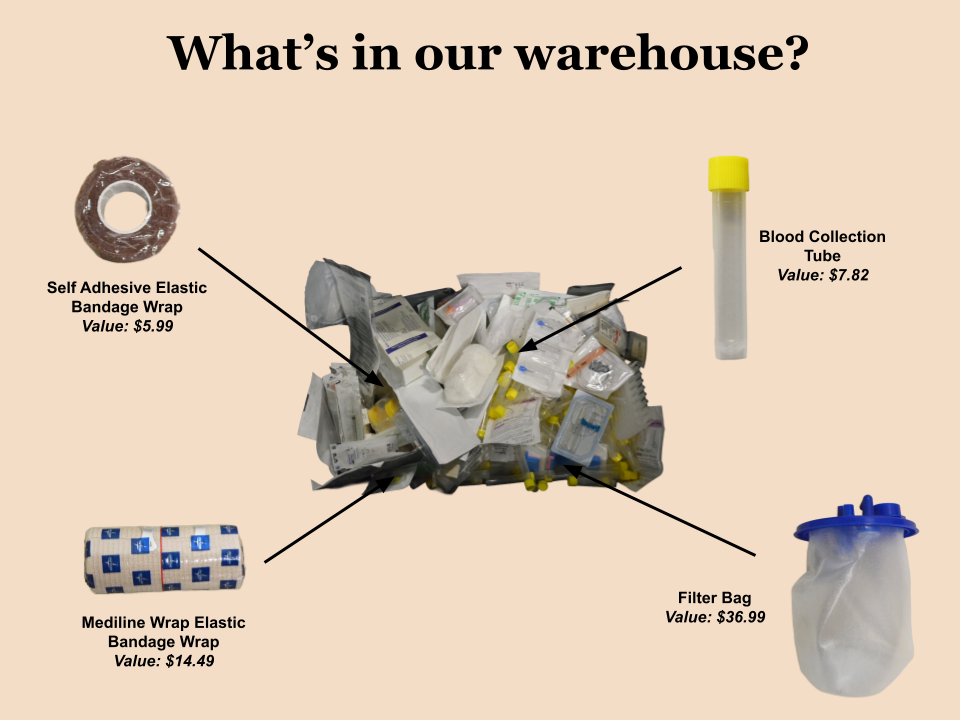Where healthcare and sustainability intersect: The fight against medical waste

By Liya Berry and Ruhi Gulati
Every Saturday morning, a group of 20-something Michigan students drive down to a warehouse in Ann Arbor and roll open the gate to an unexpected site— rows of cardboard boxes on boxes at least five feet high, all filled to the brim with thousands of random, unused medical supplies that were headed towards one place: the landfill.
Ranging from syringes to knee braces to alcohol prep pads, these pallets of unopened, perfect condition medical supplies from Michigan Medicine are intercepted, saving over $250,000-worth of equipment from being thrown out. These supplies are then inventoried by the college students, to clinics across the world that provide free medical care for those with barriers to basic healthcare.
Everywhere on the news we hear political debates about healthcare spending, like cuts to Medicaid or the benefits of universal healthcare. But this is not a story about the tremendous amounts of money that goes into healthcare, it is about the mass of money coming out, or rather getting dumped straight into the trash can.
When discussing healthcare affordability, policy is often at the forefront of the conversation around cost reduction; however, a much more attainable way is often overlooked— reducing medical waste.
What is medical supply waste?
Medical waste is unopened, sterile, or non-sterile medical supplies that are unused and thrown out by hospitals and healthcare clinics. Much of medical waste production can be attributed to a wide range of complex and interrelated issues within hospitals, such as clinical inefficiencies, missed prevention opportunities, overuse, administrative waste, and excessive prices. Even just a few rounding errors within hospital supply chain management may be deemed miniscule when in reality, they are not.

In the U.S., waste generated by healthcare companies totals to about $760 billion to $935 billion, accounting for approximately 25% of total healthcare spending. This means that one quarter of healthcare spending could be avoided through the elimination of medical waste alone. Healthcare spending has popularly been classified as inefficient, and efforts to relieve high costs have been mostly focused on policy interventions, however, efforts towards eliminating medical waste require no debates or political disagreements, just our human effort.
Not only does the accumulation of wasted medical supplies become an additional cost to high healthcare prices, but it takes a toll on the environment as well. The global health sector contributes to 4.4-5.2% of total carbon emissions, and amid those numbers are wastage of medical supplies. In comparison, aviation, a popularly critiqued carbon emission producer, contributes around 2-5%. The striking similarities between environmental degradation from the healthcare and airplane industry only further pushes to put medical supply waste at the forefront of sustainability efforts.
While the matter at hand is definitely a global concern, medical waste is especially prevalent in our hometown of Ann Arbor. According to a study at UCSF, medical centers waste about $1,000 of medical supplies per surgery. In 2021, the Michigan Medical Center conducted about 67,514 surgeries, which using the value determined by UCSF, would lead to 67 million dollars-worth of medical waste in a year from just one department.
How do we solve this problem?
One solution would be diverting the mounds of would-be waste from landfills through donations. According to a John Hopkins research report, 2 million pounds of medical supplies can be recovered from U.S healthcare systems, and of these supplies, $15.4 million worth can be donated per year. When we all, medical providers and recipients alike, remain conscious of our medical waste, and distribute efforts towards limiting waste and donating excess supplies to medical surplus recovery organizations, we make an impact.
Our collective impact can address health inequities caused from high healthcare costs and unsafe environments while also improving global health. It was estimated that donating supplies to resource-poor facilities costs US $2.14 per DALY averted - a measure that reflects the number of healthy years of life saved by an intervention. That is a significant difference when taking a small hospital in Bangladesh’s cost of US $11 per DALY averted.
Other solutions to the problem of medical waste within hospitals include:
- A price transparency feedback system that allows physicians to compare where they stand relative to their peers in terms of cost per procedure
- The reprocessing of medical devices by an FDA-approved third party company and sold back to the hospital for about half the original sales price; medical devices that qualify for repurposing include ultrasound and electrophysiology catheters and cables, endoscopic devices, tourniquets/blood pressure cuffs, balloon inflation devices, compression devices, etc.
- The avoidance of single-use plastics, specifically disposable surgical masks and other essential personal protective equipment
Yet, perhaps the easiest solution to implement remains to be donating excess medical supplies through medical surplus recovery organizations (MSRO) that collect, process, and redistribute surplus medical equipment to communities in need.
In fact, right here in Ann Arbor, a group of University of Michigan students run a 501(c)(3) not-for-profit doing just that. Known as Blueprints for Pangaea, they have donated upwards to 9 million dollars worth of supplies since its formation to areas across the world from Agua Prieta, México to Ahmedabad, India.
By donating excess medical supplies, whether you are a college student or a healthcare worker or even a patient, you can make a difference. We can all be more cognizant about our consumption, from counting the number of masks we wear to choosing to donate over trashing unused supplies.
In the end, small, deliberate changes—when embraced collectively—have the power to reshape the health of our planet and the future of healthcare by lowering prices and increasing equity. The work starts now, and it starts with all of us.
About the Authors
 Liya Berry is an undergraduate student pursuing a dual degree in Community and Global Public
Health and Economics. As an analyst at Blueprints for Pangaea, she is able to carry
her passions surrounding health equity and sustainability. She hopes to work at the
intersection of healthcare and business to promote equitable and sustainable operations.
Liya Berry is an undergraduate student pursuing a dual degree in Community and Global Public
Health and Economics. As an analyst at Blueprints for Pangaea, she is able to carry
her passions surrounding health equity and sustainability. She hopes to work at the
intersection of healthcare and business to promote equitable and sustainable operations.

Ruhi Gulati is an undergraduate student studying neuroscience and public policy through the Gerald R. Ford School. She plans to apply her skills gained through her position as Vice President of Expansion at Blueprints for Pangaea to her future career as a physician who is passionate about increasing access and equity in the medical world.
